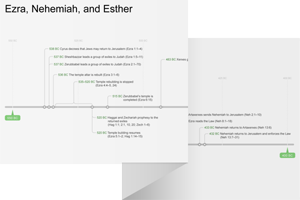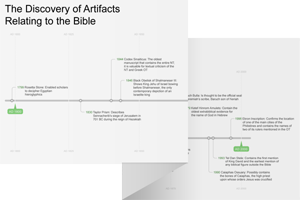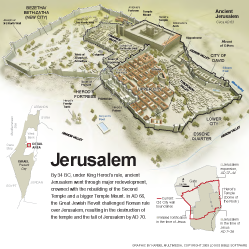1:1–11 The book of Ezra |
1:1 the first year of Cyrus 539 bc, the year in which Cyrus conquered Babylon and became king over all of Mesopotamia. Cyrus founded the Persian Empire.
Cyrus II |
Date | Event |
Cyrus becomes king of Persia | 559 bc |
Cyrus conquers Babylon | 539 bc |
Cyrus allows Jews to return to Jerusalem | 538 bc |
king of Persia A title rarely used for early Persian kings.
kings.
the mouth of Jeremiah Likely refers to Jer 25:11–12 and Jer 29:10, where the prophet predicted 70 years of captivity for the Jews. See note on Jer 25:11.
predicted 70 years of captivity for the Jews. See note on Jer 25:11.
the spirit of Here, the Hebrew term for “spirit” is used in reference to mental will (see Ezra 1:5). Via God’s influence, Cyrus willingly allowed the Jews to return to Jerusalem. Likewise, God gave individual Jews a desire to return to the land (v. 5).
gave individual Jews a desire to return to the land (v. 5).
1:2 has given me all the kingdoms of the earth A similar decree appears on the Cyrus Cylinder.
the God of the heavens Rarely used prior to the exile, this title for God became popular among the Jews during and after the exile (see 5:11, 12; Neh 1:4, 5; Dan 2:18, 19).
 The Name Theology of the Old Testament
The Name Theology of the Old Testament
a house The original temple in Jerusalem, built by Solomon, was burned by the armies of Nebuchadnezzar when they destroyed Jerusalem in 586 bc (2 Kgs 25:9; 2 Chr 36:19).
Judah Refers to the geographical location of Jerusalem, not the southern kingdom.
1:3 all of his people While the Assyrians and Babylonians
and Babylonians regularly exiled vanquished nations and transplanted foreigners to conquered territories, the Persians allowed captive nations to return to their homelands. Cyrus hoped that his benevolence would lessen the risk of revolutions throughout his empire—happy citizens rarely rebel.
regularly exiled vanquished nations and transplanted foreigners to conquered territories, the Persians allowed captive nations to return to their homelands. Cyrus hoped that his benevolence would lessen the risk of revolutions throughout his empire—happy citizens rarely rebel.
may his God be with him A customary way of wishing someone a safe journey, similar to the term “godspeed.”
may he go up to Jerusalem The Hebrew term for “go up” is used throughout the ot to designate a trip to Jerusalem (e.g., 2 Sam 19:34; 1 Kgs 12:27; 2 Kgs 12:17; Zech 14:17). Since Jerusalem is situated at the top of a mountain, travelers must literally climb up to the city.
(e.g., 2 Sam 19:34; 1 Kgs 12:27; 2 Kgs 12:17; Zech 14:17). Since Jerusalem is situated at the top of a mountain, travelers must literally climb up to the city.
the God of Israel Demonstrates the Persians’ tolerance of other religions.
1:4 survivor The Jews who survived the exile (see Isa 10:20–21).
the men of that place Refers to the neighbors of the Jews who have decided to return to Jerusalem. The national heritage of these neighbors is unclear. The phrase may refer to Gentile neighbors, or Jews who remained in exile.
1:5 Judah and Benjamin The primary tribes taken to Babylon when Nebuchadnezzar destroyed Jerusalem. While only these tribes are mentioned, they are not the only ones who were exiled.
the priests and the Levites Those who return are divided into three social groups: laity, priests, and Levites.
and Levites. This threefold designation is repeatedly used in Ezra to denote the entire population (see Ezra 2:1–58; 3:8, 12; 6:16; 7:7, 13; 8:15, 29; 9:1; 10:5, 18–43).
This threefold designation is repeatedly used in Ezra to denote the entire population (see Ezra 2:1–58; 3:8, 12; 6:16; 7:7, 13; 8:15, 29; 9:1; 10:5, 18–43).
1:7 the objects of the house of Yahweh Nebuchadnezzar took the vessels to Babylon during his campaigns against Judah (605–586 bc). They were mistreated by Belshazzar (Dan 5).
the house of his gods Refers to the various temples of the gods worshiped by Nebuchadnezzar, including Marduk and Nabu.
and Nabu.
1:8 Mithredath the treasurer Probably the senior Persian financial officer in Babylon. Another Mithredath—mentioned in Ezra 4:7—served during the days of Artaxerxes, at least 80 years after the events of this chapter.
in Babylon. Another Mithredath—mentioned in Ezra 4:7—served during the days of Artaxerxes, at least 80 years after the events of this chapter.
Sheshbazzar The Babylonian name Sheshbazzar means “may Shamash protect the son.” Shamash was the Babylonian sun god. Sheshbazzar’s exact identity is unknown. The epithet “prince of Judah” indicates that Sheshbazzar was a member of the royal family.
means “may Shamash protect the son.” Shamash was the Babylonian sun god. Sheshbazzar’s exact identity is unknown. The epithet “prince of Judah” indicates that Sheshbazzar was a member of the royal family.
1:11 All of the objects of gold and silver metal were five thousand four hundred The total number of the temple vessels identified in vv. 9–10 is 2,499. The reason for this discrepancy is unknown.
Babylonia Babylon was one of the oldest cities of civilization. See note on Mic 4:10.
Babylon |
to Jerusalem Even in the midst of their march into exile, God promised the Jews that He would bring them back to the land that had been promised to them and here he does so (Jer 31:15–17).

|
About Faithlife Study BibleFaithlife Study Bible (FSB) is your guide to the ancient world of the Old and New Testaments, with study notes and articles that draw from a wide range of academic research. FSB helps you learn how to think about interpretation methods and issues so that you can gain a deeper understanding of the text. |
| Copyright |
Copyright 2012 Logos Bible Software. |
| Support Info | fsb |
 Loading…
Loading…


 Cyrus
Cyrus 



 Babylon
Babylon